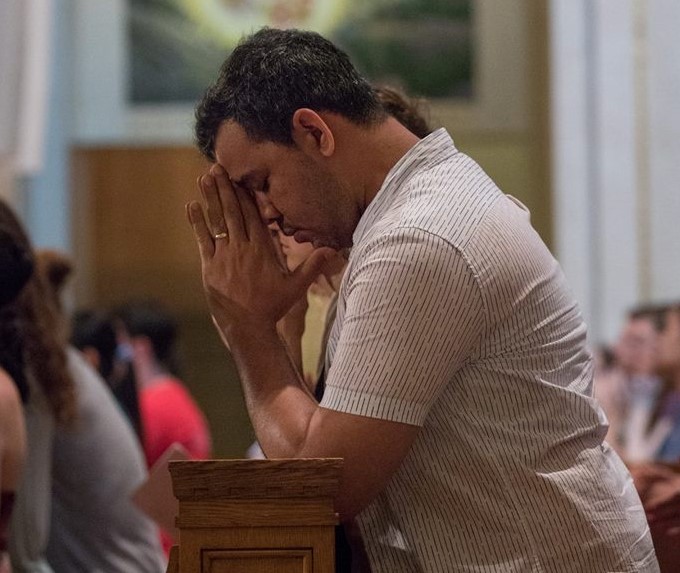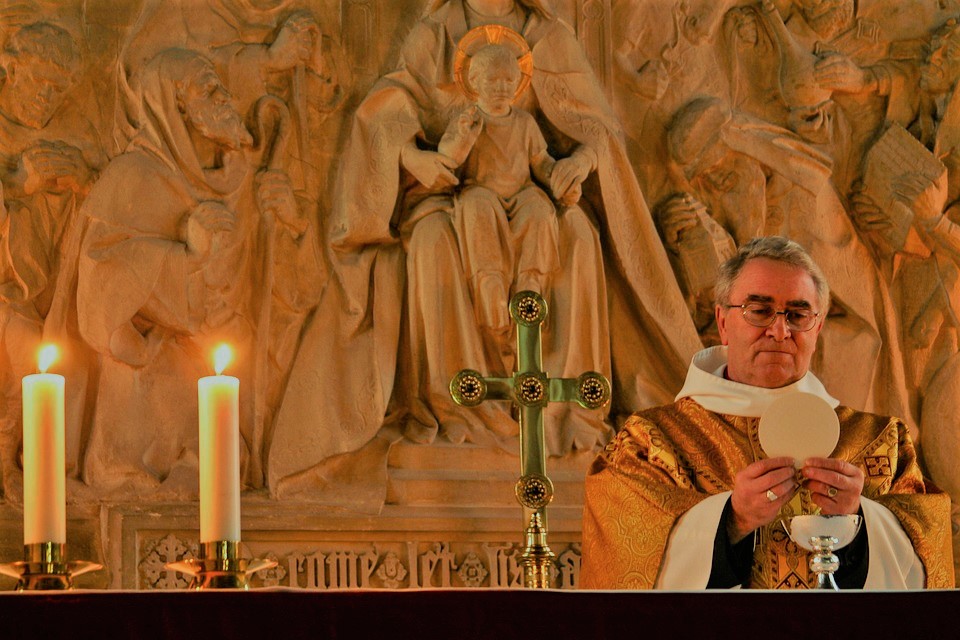Let’s consider three rather humble but important moments that are often lost in the minds and hearts of the faithful – the Mystery of Faith, the Amen, and the Agnus Dei. They rise in importance because they are moments that belong especially to the faithful rather than the clergy.
I. The Mystery of Faith (Memorial Acclamation)
In the Ordinary Form of the Liturgy, an acclamation of the people has been added just after the consecration. The priest bids them to acclaim the paschal mystery that has just been made present in the Eucharistic Sacrifice.
In effect, this addition to Mass is the “Pauline Comment.” It is so named for the fact that after repeating the words of consecration, St. Paul adds a kind of comment:
For I received from the Lord what I also passed on to you: that the Lord Jesus, on the night He was betrayed, took bread, and when He had given thanks, He broke it and said, “This is My body, which is for you; do this in remembrance of Me.” In the same way, after supper He took the cup, saying, “This cup is the new covenant in My blood; do this, as often as you drink it, in remembrance of Me.”
For as often as you eat this bread and drink this cup, you proclaim the Lord’s death until He comes. (1 Cor 11:23-26)
Critics of the Memorial acclamation see it as a novelty and intrusion into the Roman Rite. They also see it as given merely to imitate the Eastern rites or to give the people something to do in a prayer otherwise uttered entirely by the priest to the Father. But, as noted, the intrusion is not a merely arbitrary insertion, it draws from Paul’s comment on the words of consecration.
However, the criticisms are not without any merit. This practice was largely unknown in the Western rite, and, if the response of the people is desired, it is complicated by the fact that three different versions are offered, each of which differ in ways from the “Pauline comment” as recorded in scripture.
All of this said, the response is there and the faithful are asked to make an acclamation by the celebrant. He says or sings “The mystery of faith.” At this point the rubrics indicate “And the people continue, acclaiming …” Note that it is not anticipated that the priest should join them. At other times the rubrics do dictate that the priest and people sing together. (For example, at the Sanctus the rubric states, “[The priest] joins his hands and concludes the Preface with the people, singing or saying aloud …”)
But in the case of the Mystery of Faith, the rubric simply says, “the people continue, acclaiming …” There are three options:
1. We proclaim your death or Lord, and profess your resurrection, until you come again.
2. When we eat this Bread and drink this Cup we proclaim your death O Lord, until to come again.
3. Save us Savior of the world, for by your Cross and Resurrection, you have set us free.
As noted, these acclamations echo the practice of the Eastern Churches, which contain several acclamations by the people during the Eucharistic Prayer (specifically the Anaphora). For example, in the Liturgy of St. John Chrysostom, the people sing “Amen” after the consecration of the bread and again after the consecration of the wine. The priest then sings, Thine own, of thine own, we offer unto thee, on behalf of all and for all. And the people respond, We praise thee, we bless thee, we give thanks unto thee and we pray unto thee, Lord our God.
The people’s response, not the priest’s. The memorial acclamation is a moment for the people to acclaim the paschal mystery that has just been made present to them. Too often, unfortunately, they seem distracted or uninvolved. Clergy should not usurp the acclamation for themselves by singing or saying it too loudly. Even if it is necessary to “get the people started,” the priest should then pull back and listen reverently to the response that really belongs to the congregation. This is a moment for the people of God to express their praise and worship of the Lord, now present on the altar, in a reverent fashion. They also express by the acclamation that the passion, death and resurrection are made present to them. It belongs to us clergy to instruct the faithful on the meaning and importance of this moment in terms of Eucharistic piety and faith.
II. Amen
The Amen at the end of the Eucharistic prayer is another moment for God’s people to acclaim their “yes,” solemnly and joyfully, to what has just taken place. In this case as well, the speaking or the singing of the “Amen” is assigned to the people, not the clergy. The rubrics state, “The people acclaim: Amen.”
The celebrant, in persona Christi Capitis, has been speaking to the Father on their behalf, recalling the great works of God and the Sacrifice of the Cross made present in the Eucharist. He has asked mercy for the Church: the clergy and all the people, living and deceased.
At the conclusion, the celebrant and deacon hold aloft the Body and Blood of the Lord and sing or say, Through him and with him and in him, O God almighty Father, in the unity of the Holy Spirit, all glory and honor is yours, forever and ever. It is for the people, not the celebrant, to acclaim “Amen.” It is their “yes,” their acknowledgment of all that has been said and has taken place.
Thus, the “Amen” ought to be a vigorous one. There is no need for histrionics, but a good, firm “Amen” is surely called for as a sign of our Eucharistic faith and our grateful hearts. At times, though, it seems one can barely detect the joy and firm affirmation that is deserved. Eucharistic piety demands more than a distracted, feeble “Amen.”
III. The Agnus Dei
Just prior to the Agnus Dei, the optional (though seldom omitted) sign of peace is sung or said. Unfortunately, there are often excesses in what ought to be a modest greeting to those immediately nearby. These excesses often lead to the eclipse of what is a beautiful and pious hymn of preparation for Holy Communion: Lamb of God you take away the sins of the world, have mercy on us … grant us peace.
The recitation or singing of the Agnus Dei begins just after the sign of peace, but many people do not take the hint to refocus and join in. Instead they continue glad-handing as if it were merely background noise/music to the sign of peace. It is not. It is part of a eucharistic piety meant to prepare us for Holy Communion. Consider that the words of the hymn are very tender. We sing to Him who is the Lamb of God, present on the altar, to have mercy on us and grant us peace to approach the Eucharistic altar without servile fear.
The Agnus Dei is especially a song of the people, because the celebrant is usually busy with other prayers. He may join towards the end, but this is a moment for the people to prepare themselves for Holy Communion.
Here, then, are three acclamations of Eucharistic piety that help frame the liturgy and draw us to devotion. My sense is that they are underappreciated by many of the faithful and that clergy often usurp the role given to the lay faithful here, sometimes even acting as a “song leader.”
Ideally, the faithful can discover their own role here and see that the acclamations are not mere formulae, but prayers of a people who believe and celebrate what is announced.
Cross-posted at the Catholic Standard: Three Underappreciated Acclamations of Eucharistic Piety





